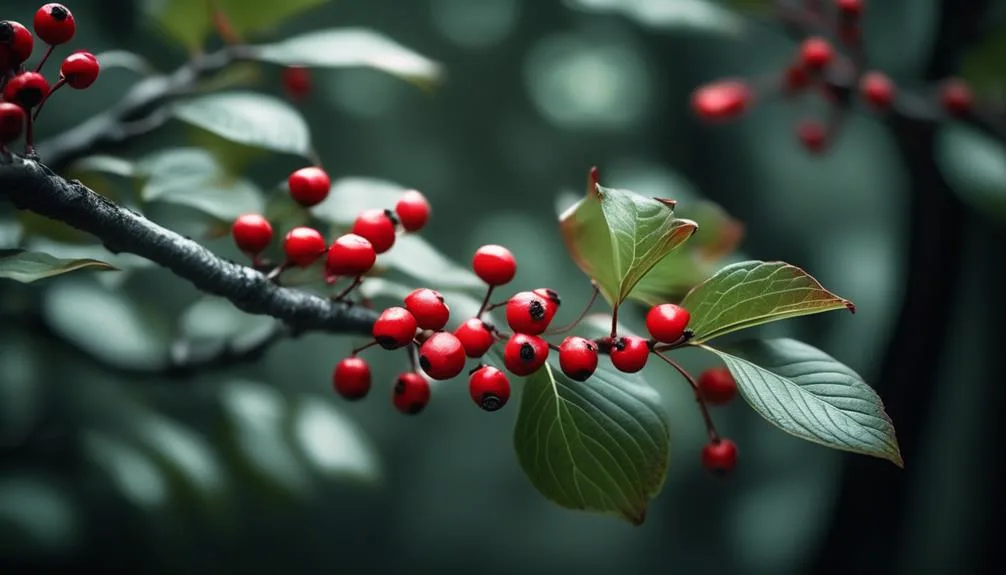Dogwood trees display bright red berries on their branches, adding a colorful touch to the scenery. Ever wondered why? The reason behind this is quite fascinating and offers insights into nature's intricacies.
These striking red berries serve an essential role in the ecosystem. Let's explore the mystery behind why dogwood trees bear these eye-catching red berries and the critical function they fulfill in the natural world.
Dogwood Tree Species
Discover the diverse and captivating world of dogwood tree species, each boasting its own unique characteristics and beauty.
Dogwood trees are known for their stunning blooms, which vary in color and flowering time depending on the species. The flowering time typically ranges from early spring to early summer, with colors spanning from white and pink to red and even yellow.
In terms of tree size and shape, dogwoods come in various forms, from small shrubs to large, multi-stemmed trees. Their shapes can be vase-like, rounded, or spreading, adding to the allure of these beautiful trees.
Understanding the different features of each species can help you select the perfect dogwood tree for your landscape, ensuring a vibrant and picturesque addition to your outdoor space.
Purpose of Red Berries
Red berries on dogwood trees serve a crucial ecological purpose, attracting birds and other wildlife with their vibrant color and nutritious fruit. The purpose of these red berries goes beyond aesthetics; it plays a vital role in the survival of the dogwood tree species and the broader ecosystem.
Here's why they're essential:
- Wildlife Attraction: The bright red color of dogwood berries acts as a visual cue for birds, inviting them to feast on the fruit.
- Nutritious Fruit: The berries provide essential nutrients for wildlife, aiding in their survival, especially during harsh winters.
- Seed Dispersal: After consuming the berries, birds and other animals help disperse the seeds, allowing for the propagation of dogwood trees in various locations.
The synergy between dogwood trees and wildlife through these red berries is a remarkable example of nature's interconnectedness.
Reproduction and Seed Dispersal
The process of reproduction and seed dispersal in dogwood trees involves a fascinating interplay between the tree's biological mechanisms and the assistance of wildlife. Dogwood trees rely on a pollination process facilitated by insects, such as bees and butterflies. These insects are attracted to the dogwood's flowers, where they collect nectar and inadvertently transfer pollen from one flower to another, enabling fertilization.
Once fertilized, the dogwood tree produces small red berries that serve as a vital food source for birds and other wildlife. The dispersal methods of these berries are crucial for the tree's reproduction. Birds consume the berries and then disperse the seeds through their droppings, allowing the seeds to be spread over a wider area and increasing the chances of successful germination and growth for new dogwood trees.
Environmental Factors
In considering the environmental factors that influence the growth and health of dogwood trees, it's essential to understand the significance of soil composition and moisture levels. These two factors, along with climate variations, play a crucial role in determining the overall well-being of dogwood trees.
- Climate variations: Dogwood trees thrive in temperate climates with well-defined seasons. They require a period of dormancy during the winter to set buds for the following spring.
- Soil composition: Dogwood trees prefer well-drained soils with a slightly acidic pH. The presence of organic matter in the soil is also vital for their growth and development.
- Moisture levels: Consistent moisture levels are essential for dogwood trees. They prefer soil that's moist but not waterlogged, as excessive moisture can lead to root rot and other diseases.
Significance to Wildlife
Amidst the forest's lush greenery, dogwood trees provide a vital source of sustenance and shelter for various wildlife species, enriching the ecosystem with their vibrant blooms and nourishing red berries. The significance of dogwood trees to wildlife habitat and food sources is remarkable. The table below summarizes the importance of dogwood trees to wildlife:
| Wildlife Significance | Description |
|---|---|
| Food Source | Dogwood berries are a crucial food source for birds, squirrels, and deer. |
| Shelter | The dense foliage and low-hanging branches offer shelter for small animals. |
| Biodiversity | Attracts a diverse range of insects, contributing to the overall food chain. |
| Nesting Sites | Birds often build their nests in the sturdy branches of dogwood trees. |
| Seasonal Dependence | Many wildlife species rely on dogwood berries during the winter months. |
Dogwood trees play an integral role in supporting the intricate web of life within the forest ecosystem.
Conclusion
In observing the vibrant red berries on dogwood trees, we witness their crucial role in reproduction and wildlife sustenance.
These trees' adaptation and ecosystem contribution remind us of nature's intricate balance.
Let's appreciate the significance of these berries and their impact on the environment.

My interest in trees started when I first saw the giant sequoias in Yosemite.
I was a teenager then, and I remember thinking, “I need to learn more about this.”
That moment stuck with me.
A few years later, I went on to study forestry at Michigan Tech.
Since graduating, I’ve worked in a mix of hands-on tree care and community education.
I’ve spent over ten years helping people understand how to plant, maintain, and protect the trees in their neighborhoods.
I don’t see trees as just part of the landscape.
They are living things that make a real difference in our daily lives.
